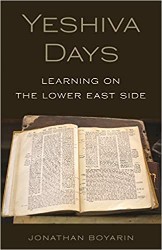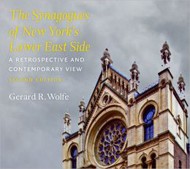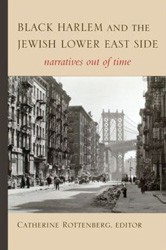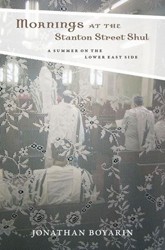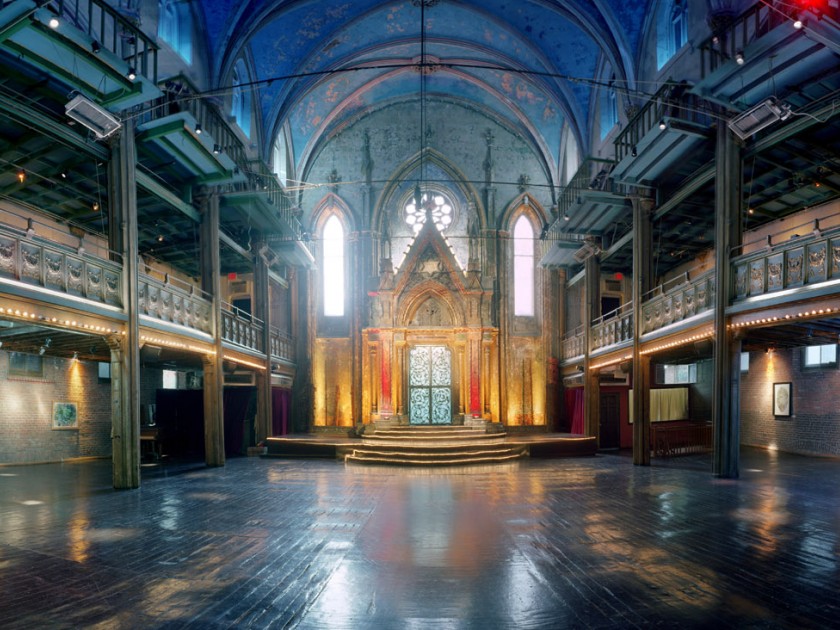
Angel Orensanz Center, art and performance center located on the Lower East Side, originally constructed as a synagogue in 1849; image via Wikimedia commons
I live on the Lower East Side. No, I lived there — for over forty years. The neighborhood was the first place that really felt like home since my early childhood in a community of immigrant and refugee chicken farmers in Farmingdale, New Jersey. I loved its changing mix: the jostle of older and newly arrived populations — especially full of Jewish traces. It retained enough Jewish life for my wife, Elissa, and I to feel that we could still be part of a living, warm, and argumentative local Jewish community. I felt like I belonged there, and at the same time there were endless possibilities for exploring Jewish identity and expression.
I could wait on line for round challahs at Moshe’s Bakery on the day before Rosh Hashanah, and be scolded by a cranky Jewish elder for — allegedly — cutting the line (to this day I really think I didn’t). I could come back another day, later in the winter, and find to my surprise the shelves once again full of round challahs. Sarah, the elderly woman born in Belgium who worked at Moshe’s and on the side sold eggs to raise money for Hadassah, was at the counter. She explained to me that they were for the Ukrainian New Year. “For the Ukrainian New Year?” I repeated, since this was entirely new to me. “Sure,” she retorted, “The Jews have a New Year, the Chinese have a New Year, why shouldn’t the Ukrainians have one, too?”
As soon as I moved in, during the late 1970s, I discovered the B&H Dairy Restaurant, a block up from the bakery. It’s still there in 2020, battered by a series of forced closures and now by the COVID-19 pandemic, the last Jewish dairy restaurant in New York City. Back when I first moved in Leo and Dave were working there; Leo was dour, and people joked about whether the “LEO omelet” was named after him or for its ingredients of lox, eggs, and onions. And Dave was tough. I asked him why the restaurant didn’t carry English muffins and he growled, “The Thomas’s delivery man is an antisemite.” Once when I sat at the narrow counter, a young couple appeared in the doorway. Dave looked at the young woman, then said to her companion, “That’s the nicest looking girl you came in here with yet!”
And I found a shul, then more than one. First the old Eighth Street Shul, east of Tompkins Square Park, where I was instantly welcomed and counted in the minyan — the quorum of ten required for a Jewish prayer service — with no questions asked about my level of learning or Orthodoxy. Eighth Street was perhaps the first part of the Lower East Side to which I turned my anthropologist’s gaze, writing in the 1980s about the unlikely combination of tradition and marginality that afforded me entrée into what might in other places have been an insular Orthodox Jewish world.
When the Eighth Street congregation finally collapsed, the building was sold, and I began regularly attending the synagogue a few blocks to the south that was then called, “Rabbi Singer’s shul” — after the tsaddik who kept it going and saw to it that his small congregation was fed and warm. In time, and not without contention, Rabbi Singer moved on, and the place became known simply as the Stanton Street Shul. For years I wanted to write a book about it, but its membership and hence the entire sensibility of the place kept changing so fast that at one point I called it, “The shul that wouldn’t sit still for its ethnographic portrait.” Eventually I hit on the expedient of documenting one summer in the life of the shul’s daily morning services, and Fordham University Press published my book Mornings at the Stanton Street Shul: A Lower East Side Summer. The account I produced seems deceptively casual: the anecdotes I recount there actually reflect thirty years of watching the congregation shift, and even more years of thinking about the dynamics of diasporic or “minor” cultural forms, those that don’t fit in neatly with the dominant identities of nation-states.
I could wait on line for round challahs at Moshe’s Bakery on the day before Rosh Hashanah, and be scolded by a cranky Jewish elder for — allegedly — cutting the line.
What drew me initially to the Lower East Side was its heritage of Yiddish arts and culture, for indeed Yiddish was the aspect of Jewish studies that I loved first and best. But I always knew I wanted to become a more literate student of rabbinic literature as well. And for that, as early as 1984 I was directed to the large beis medresh (study hall) at Mesivtha Tifereth Jerusalem (MTJ), at this point the only yeshiva on the Lower East Side. I immediately fit in with the group of young adult beginners there, being tutored an hour each day in Pentateuch and Talmud. Eventually I was inspired to write an article for a scholarly journal in my field, about the special characteristics of reading as a fully social activity in the yeshiva.
Although I stayed in the neighborhood, I barely stepped into MTJ after the 1980s, until one Sabbath morning I explained to a fellow congregant that I had a term of leave coming up from my academic job, and wasn’t sure how I would spend it. “Why don’t you go to the shiur [lesson] that the Rosh Yeshiva [head of the yeshiva] gives every morning at 11:00?” I decided that was a great idea — and that’s how I came to spend a year studying at MTJ in 2012, to continue going there whenever I got the chance afterward, and now, to publish a book about what it’s like to study there and why I love the place so much (Yeshiva Days: Learning on the Lower East Side, Princeton University Press). It took me a long time to write the book, because I knew I wanted to keep it short — and even more, because I was determined to write an account that I could bring back into the beis medresh and share with my fellow students there, not just more grist for the academic mill.
My first copy of Yeshiva Days arrived in the mail today, in Ithaca, where I teach. Meanwhile much has changed: the Rosh Yeshiva’s shiur stopped in March when all of New York’s institutional life was put on pause, and it’s not clear when it will be resumed. My wife and I decided it was time to move to higher ground, so we sold our apartment and bought a place in Washington Heights. I don’t know when she and I will consider it medically safe for me to travel downtown regularly, or to sit for hours with others at the long tables in the beis medresh. It’s nice to have a book about MTJ, and it’s even nicer that I’m the one who wrote it. But it would be — will be? — even nicer to be sitting and learning there again.
Jonathan Boyarin is the Diann G. and Thomas A. Mann Professor of Modern Jewish Studies at Cornell University. His books include Jewish Families, Mornings at the Stanton Street Shul: A Summer on the Lower East Side, and The Unconverted Self: Jews, Indians, and the Identity of Christian Europe.
